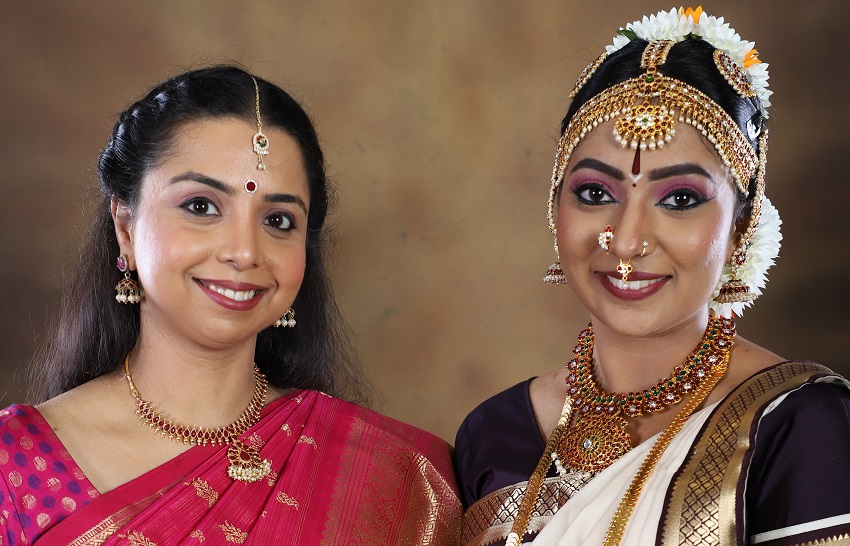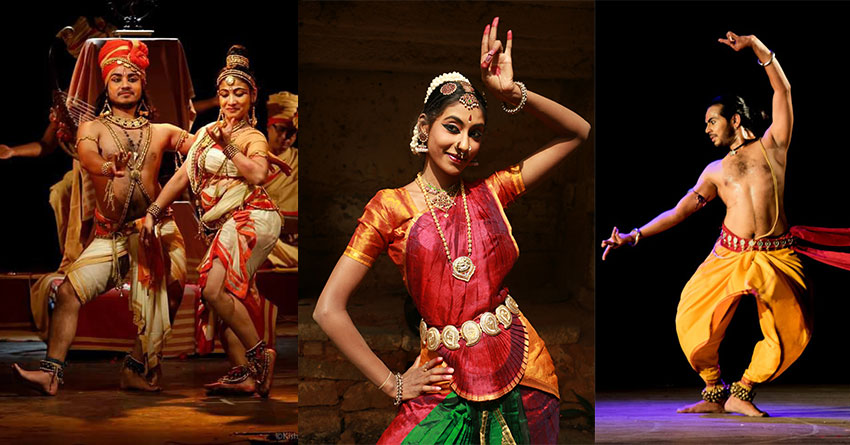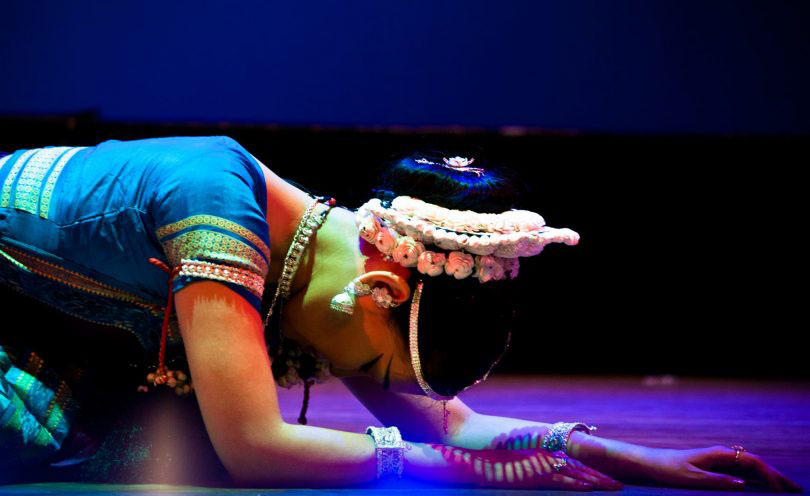Divine spaces and Kshetras exploring the deity and his/her kshetram or dwelling drew unprecedented crowds at Seva Sadan, Bangalore on 3rd, 4th, and 5th October 2018. The event was a part of the well know arts consultant Usha Rk’s 40 years in arts. The festival was conceived and curated by her.
 In previous reports Madhulita & Soundarya’s unique presentation on Lords of Puri and Tirupati and Navia and Vidha enrapture audience with Devi Meenakshi & Ambaji depiction, we reported performances of day one and two. Here’s the report of concluding Day-3 performances.
In previous reports Madhulita & Soundarya’s unique presentation on Lords of Puri and Tirupati and Navia and Vidha enrapture audience with Devi Meenakshi & Ambaji depiction, we reported performances of day one and two. Here’s the report of concluding Day-3 performances.
The concluding day explored two divine kshetras extolling the Leela’s of one of the most colourful and loved deity Lord Krishna.
Krishna Kshetram included Udupi Krishna as “Dasaradeva” by Ustad Bismillah Khan Yuva Puraskar awardee (Sangeet Natak Akademi) Ragini Chandershekar and Nathdwara Srinath ji by Jaipur Gharana’s popular kathak dancer and Guru Abhimanyu Lal.
The presentation in Bharatanatyam by Ragini centred around the exquisite deity of Krishna at the holy temple town of Udupi in Karnataka, a pilgrimage spot for devout Hindus. The “Madhwa” cult of Madhwacharya saw the complete immersion of the devotee in Krishna. The ‘Dasa’ poets like Purandaradasa, Kanakadasa, Mohanadasa and several others sang in an ecstatic abandonment of their deep love for Krishna. They were also against ritualistic worship and believed that the highest form of enlightenment lay only in the utterance of the name of Krishna. From such an ideology flowed soul-stirring poetry in Kannada that celebrates the splendorous Lord of Udupi.

Ragini’s performance began with a Pushpanjali in Ragam Mohanam set to Misra Chapu Talam. The pushpanjali was followed by a composition of Mohanadasa that directly addressed ‘ Udupina Krishna ‘. The poet says, “O mighty lord of Udupi, why do you show such attitude towards me? I am but a poor, humble man pushed into this ocean of worldly miseries. You, who have pushed me thus, now watch my plight with that soft smile playing on your face. Is this fair? I have not come to you for worldly pleasures and enjoyment. All that I seek is devout bhakti and enlightenment at your feet. O Lord of Mohanadasa, the one who reclines on the mighty serpent, please give me a simple solution to cross over this ‘bhavasaagara’. From the very first segment, Ragini displayed abundant confidence, exacting footwork and optimal expressions.
The pièce de résistance of the performance was a composition of Purandaradasa in Ragam Brindavani and Adi Talam that described the enchanting beauty of the dancing Sri Krishna. “Ta tat ta dhimita dhimikita” danced the cowherd lord. The father of Brahma, with diamond studded jewels around his neck, He danced magnificently wearing a sparkling necklace and the pendant, the keyoora and his stunning crown. As he dances the beautiful gopis in groups enjoy this beautiful sight of Nanda Gopala, the one who is eternal bliss himself. The dance choreography highlighted the magical effect of the Lord’s dance on Nature and its elements.
The finale of the presentation was a soul-stirring, extremely popular composition of Kanakadasa. This pious worshipper of Krishna was denied entry into the Udupi temple as he was untouchable. So pleased was the lord with his devotion that the idol at Udupi that usually faces the east turned miraculously to face west and there was a crack in the wall wide enough for Kanakadasa to have darshana of the lord. In this poignant piece, Kanakadasa pleads with the lord, “Bagilanu teredu seveyanu kodu Hariye, Open the door and let me have a glimpse of you”. My repeated calling out to you does not seem to affect you, O Narahari!. Ragini elaborated the episodes of Gajendra as he called out to Adumoola, of Prahlada who stood in deep bhakti and belief and finally as Draupadi sought his help while being disrobed at the time when the lord was peacefully resting on the serpent Adisesha with his consort Lakshmi by his side. Immediately in the flash of a moment, he came on Garuda to his rescue. As Narasimha, he broke the pillar with tremendous fanfare and blessed Prahlada and rescued Draupadi from humiliation. It is believed that as Kanakadasa came to the end of this tearful lament, the lord at Udupi turned around, and Kanakadasa had the darshana through the ‘kanakanakindi’- a spot considered most auspicious for darshanam even today at the temple. This was a moment of utter joy and is a revelation of a miracle of the lord. Ragini excelled in the dramatic exposition of the lord giving his devotee the vision he pleaded for.
[adrotate group=”9″]
Juxtaposed with Dasaradeva of Udupi was Shri Nath Ji of Nathdwara performed by Abhimanyu Lal from Delhi. Nathdwara is located in the Aravalli hills on the banks of the Banas River in Rajsamand (Rajasthan). This town is famous for its temple of Krishna which houses the deity of Shrinathji, a 14th-century, 7-year-old “infant” incarnation of Krishna. The deity was originally worshipped at JATIPURA Mathura and was shifted in 1672 from Govardhan hill, near Mathura along holy river Yamuna after being retained at Agra for almost six months.

The U-shape tilak on the forehead of Shree Nath ji represents the impression of Radha’s foot and the lotus garland is symbolic of Radha’s heart which Shrinathji keeps close to his own heart as an acknowledgement of love and dedication. The small Yamuna water container placed on the pedestal represents mother Yashoda and the throne on which the image rests is Yashoda’s lap. The lotus-shaped eyes of Shrinathji are also compared with Kamadeva’s bow. The presentation began with a lilting awakening composition where Abhimanyu portrayed mother Yashoda waking her little child Srinath ji informing him that it’s time for him to wake up as all his friends were waiting for him to take the cows for grazing. The gwal Pooja of the aath prahar pooja performed at the Nathdwara temple is what Abhimanyu related through this bhajan. Mother Yashoda offers him sweets and butter trying to bribe him in many ways to wake him up.
And as the Jhanki or curtain lifts not only mother Yashoda but the entire universe receives the darshan of little Krishna.
Abhimanyu moved into an area that he is a master at Shudha Nritya and explores the Teen taal and interwove thrilling expositions of the Jaipur gharana winding up each of them with postures from the Leela’s of Balakrishna. The kavit delineating the playing of Krishna with his sakhas and then vanquishing Kaliya created a scintillating finish to the pure dance segment.
[adrotate group=”9″]
It was the bhajan “SHARAN GAYE KO KAUN UBARYO” that served as a fitting finale not only to Abhimanyu’s recital but to the three-day dance festival exploring deities in their kshetras. Abhimanyu included two Sanchari Bhavas in this bhajan, one where little Krishna lifts his little finger to hold the GOVARDHAN mountain bringing the entire folks and animals of Braj under his benign care challenging Indra. Krishna says while you have to put in all your energies to bring this thunderstorm, my little finger can encounter your wrath and protect my bhaktas. In another asmaraniya leela Maha Vishnu confirms his omnipresence in a pillar to prove the faith of his little Bhakt Prahlad. This was the awe-inspiring vision of Vishnu in the half man half lion avatar of Narasimha as performed by Abhimanyu received a huge appreciation from the art-loving audiences of Bengaluru.
Also read:
Madhulita & Soundarya’s unique presentation on Lords of Puri and Tirupati
Navia and Vidha enrapture audience with Devi Meenakshi & Ambaji depiction
[adrotate group=”9″]










